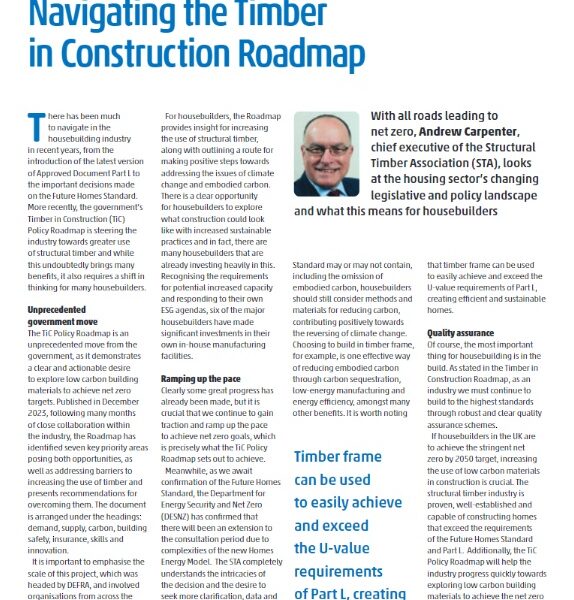Housebuilder-navigating the timber in construction roadmap
05/04/2024

There has been much to navigate in the housebuilding industry in recent years, from the introduction of the latest version of Approved Document Part L to the important decisions made on the Future Homes Standard. More recently, the government’s Timber in Construction (TiC) Policy Roadmap is steering the industry towards greater use of structural timber and while this undoubtedly brings many benefits, it also requires a shift in thinking for many housebuilders.
Unprecedented government move
The TiC Policy Roadmap is an unprecedented move from the government, as it demonstrates a clear and actionable desire to explore low carbon building materials to achieve net zero targets. Published in December
2023, following many months of close collaboration within the industry, the Roadmap has identified seven key priority areas posing both opportunities, as well as addressing barriers to increasing the use of timber and
presents recommendations for overcoming them. The document is arranged under the headings: demand, supply, carbon, building safety, insurance, skills and innovation.
It is important to emphasise the scale of this project, which was headed by DEFRA, and involved
organisations from across the sector, including the STA which led the structural timber sector involvement alongside Timber Development UK (TDUK) and Confederation of Forest Industries (Confor).
For housebuilders, the Roadmap provides insight for increasing the use of structural timber, along with outlining a route for making positive steps towards addressing the issues of climate change and embodied carbon.
There is a clear opportunity for housebuilders to explore what construction could look like with increased sustainable practices and in fact, there are many housebuilders that are already investing heavily in this.
Recognising the requirements for potential increased capacity and responding to their own ESG agendas, six of the major housebuilders have made significant investments in their own in-house manufacturing facilities.
Ramping up the pace
Clearly some great progress has already been made, but it is crucial that we continue to gain traction and ramp up the pace to achieve net zero goals, which is precisely what the TiC Policy Roadmap sets out to achieve.
Meanwhile, as we await confirmation of the Future Homes Standard, the Department for Energy Security and Net Zero (DESNZ) has confirmed that there will been an extension to the consultation period due to complexities of the new Homes Energy Model. The STA completely understands the intricacies of the decision and the desire to
seek more clarification, data and information before making a final ruling on the contents of the Future Homes Standard, and the impact this has on the industry cannot be overstated.
Despite what the Future Homes Standard may or may not contain, including the omission of embodied carbon, housebuilders should still consider methods and materials for reducing carbon, contributing positively towards
the reversing of climate change. Choosing to build in timber frame, for example, is one effective way of reducing embodied carbon through carbon sequestration, low-energy manufacturing and energy efficiency, amongst many
other benefits. It is worth noting that timber frame can be used to easily achieve and exceed the U-value requirements of Part L, creating efficient and sustainable homes.
Quality assurance
Of course, the most important thing for housebuilding is in the build. As stated in the Timber in Construction Roadmap, as an industry we must continue to build to the highest standards through robust and clear quality
assurance schemes.
If housebuilders in the UK are to achieve the stringent net zero by 2050 target, increasing the use of low carbon materials in construction is crucial. The structural timber industry is proven, well-established and
capable of constructing homes that exceed the requirements of the Future Homes Standard and Part L. Additionally, the TiC Policy Roadmap will help the industry progress quickly towards exploring low carbon building materials to achieve the net zero targets.
Read the full article here.